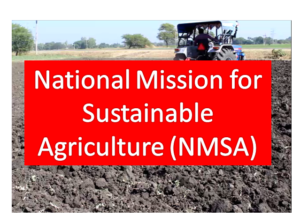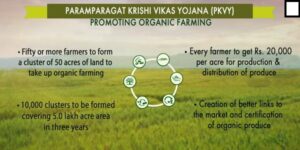Indian Economy – Agriculture – Schemes
National Mission for Sustainable Agriculture(NMSA)

- NMSA is envisaged as one of the eight Missions outlined under National Action Plan on Climate Change (NAPCC), NMSA aim at promoting Sustainable Agriculture through climate change adaptation measures.
- The major thrust is enhancing agriculture productivity especially in rainfed areas focusing on integrated farming, soil health management, and synergizing resource conservation. Besides,
- NMSA also a committed target to fulfil National and International commitments on Sustainable Development Goals (SDG) &Intended Nationally Determined Contribution (INDC). All the components of NMSA such as Rainfed Agriculture, Soil Health Management, Organic Farming, etc. have significant role in achieving SDGs & INDC.
- NMSA as a programmatic intervention caters to Mission Deliverables that focuses mainly on conservation agriculture to make farm sector more productive, sustainable, remunerative and climate resilient by promoting location specific integrated/composite farming systems; soil and moisture conservation measures; comprehensive soil health management and mainstreaming rainfed technologies.
Rainfed Area Development(RAD)
- RAD focuses on Integrated Farming System (IFS) for enhancing productivity and minimizing risks associated with climatic variability’s. Under this system, crops/cropping system is integrated with activities like horticulture, livestock, fishery, agro-forestry, apiculture etc. to enable farmers not only in maximizing farm returns for sustaining livelihood, but also to mitigate the impacts of drought, flood or other extreme weather events with the income opportunity from allied activities during crop damage.
Pradhan Mantri Krishi Sinchai Yojana(PMKSY)
- The Pradhan Mantri Krishi Sinchayee Yojana (PMKSY) was launched for providing end-to end solutions in irrigation supply chain, viz. water sources, distribution network and farm level applications.
- PMKSY not only focuses on creating sources for assured irrigation, but also creating protective irrigation by harnessing rain water at micro level through ‘Jal Sanchay’ and ‘Jal Sinchan’.
- Micro irrigation is to be popularised to ensure ‘Per drop-More crop’. PMKSY adopts State level planning and projectised execution that allows States to draw up their own irrigation development based on District Irrigation Plans and State Irrigation Plans.
Adoption of micro irrigation is providing economic benefits to farmers:
- Micro Irrigation which includes drip and sprinkler irrigation is a proven technology which has gained immense popularity amongst the farmers in India.
- Strengths of this technology include – efficient deployment of inputs such as water, electricity, fertilizers, labour etc, increase in crop productivity, better quality of produce leading to higher realization of sale price resulting in increased income of farmer and prosperity.
- With this technology, additional area can be irrigated with the same amount of water compared to conventional method of irrigation. In addition, water deficient, cultivable waste land and undulating land areas can easily be brought under cultivation due to ease of irrigation. With this technology, there is also a good scope for using it in closely spaced crops like rice, wheat, onion, potato Benefits of this technology lead to control of ground and surface water pollution.
An impact evaluation study for Micro Irrigation was carried out in the year 2014 and major findings of the study are:
- Irrigation cost reduced by 20% to 50% with the average of 32.3%.
- Electricity consumption reduced by about 31%.
- Saving of fertilizers vary from 7% to 42%.
- Average productivity of fruits and vegetables increased by about 42.3% and 52.8%.
- Overall income enhancement of farmers in the range of 20% to 68% with average of 48.5%
The positive outcomes of micro irrigation have made food security effective due to increase in production and productivity of different crops and increased area under irrigation from the same source of water resulting in enhanced nutritional security for the country.
Crop experiments have shown that use of water soluble fertilizers through drip irrigation (fertigation) can result in reduced consumption of fertilizers resulting in cost savings.
Pradhan Mantri Fasal Bima Yojana

- Under this scheme, the farmers’ premium has been kept at a maximum of 2 per cent for foodgrains and oilseeds, and up to 5 per cent for horticulture and cotton crops.
- There is no upper limit on Government subsidy. Even if balance premium is 90%, it will be borne by the Government.
- Importantly for the beneficiaries, crop losses which are covered under the scheme include Yield Losses as well as post-harvest losses, where coverage will be available up to a maximum period of 14 days from harvesting for those crops.
- The use of technology will be encouraged to a great extent resulting in operational efficiency. Smart phones will be used to capture and upload data of crop cutting to reduce the delays in claim payment to farmers. Remote sensing will be used to reduce the number of crop cutting experiments.
Mera Gaon, Mera Gaurav
- This scheme is being launched involving agricultural experts of agricultural universities and ICAR institutes for effective and deeper reach of scientific farming to the villages.
- A group of experts will be associated with one particular village to create awareness and adoption of new technologies including farm investment, loans, availability of inputs and marketing.
- All the scientists from ICAR and agricultural universities will participate in this initiative.
Krishi Dak
- IARI initiated this novel scheme in 20 districts in which postmen supplied seeds of improved varieties of crops to the farmers in far-flung areas.
- Owing to its success and popularity, this scheme is being extended in 100 districts of 14 states with the association of Krishi Vigyan Kendras.
- This will provide improved seed to farmers at their doorstep.
Soil Health Card
- Soil Health cards are necessary to ensure that only requisite nutrients are applied in the soil in a balanced manner to enhance productivity of specific crops in a sustainable manner.
- Values on soil parameters such as pH, EC, N, P, K, S, Zn, Fe, Mn, Cu & B.
- Recommendation on appropriate dosage of fertilizer application based on test values and requirement of crop, use of organic manures and soil amendments to acidic/alkaline/sodic soils.
Paramparagat Krishi Vikas Yojna (PKVY)

- Aim of the project is to maximize the utilization of natural resources through eco-friendly cultivation.
- Organic farming is a method of farming system which primarily aimed at cultivating the land and raising crops in such a way, as to keep the soil alive and in good health by use of organic wastes (crop, animal and farm wastes, aquatic wastes) and other biological materials along with beneficial microbes (bio-fertilizers) to release nutrients to crops for increased sustainable production in an eco friendly pollution free environment.
National Agriculture Market
- National Agriculture Market or eNAM is an online trading platform for agricultural commodities in India. The market facilitate farmers, traders and buyers with online trading in commodities.The market is helping in better price discovery and provide facilities for smooth marketing of their produce.
- The eNAM markets are proving popular as the crops are weighed immediately and the stock is lifted on the same day and the payments are cleared online.
- Some attractive features like MIS dashboard, BHIM and other mobile payments, enhanced features on the mobile app such as gate entry and payment through mobile phones and farmers database is helping adoption even more.
- On the e-NAM platform, farmers can opt to trade directly on their own through mobile app or through registered commission agents.
Direct benefit transfer: Fertilizer subsidies
- Under the direct benefit transfer (DBT), the fertilizer subsidy will be released to the fertilizer companies, instead of beneficiaries, after the sale is made by the retailers to the beneficiaries.
- At present, direct transfer of subsidy to beneficiaries like in LPG cannot be introduced in the fertilizer sector as the beneficiaries and their entitlements are not clearly defined
- Multiple subsidized products, urea and 21 grades of phosphatic and potassic fertilizers have different subsidy rates.
- In the case of urea subsidy varies from company to company due to different production processes, energy efficiencies of plants, vintage etc. Amount of subsidy in some fertilizers particularly urea is more than double the MRP. It will be a huge financial burden on the farmers’ pocket, to pay the MRP and subsidy upfront and receive the subsidy amount in his bank account subsequent .
Kisan Credit Card (KCC)
- Kisan Credit Card (KCC) is a credit scheme prevalent in India, which was introduced in August 1998 all over the country. The prime motive of this credit scheme is to enable farmers in having quick and timely access to affordable credit. The plan was launched by the NABARD and Reserve Bank of India.
- Participating institutions include all commercial banks, Regional Rural Banks, and state co-operative banks.
- The scheme has short term credit limits for crops, and term loans.
- KCC credit holders are covered under personal accident insuranceThe premium is borne by both the bank and borrower in a 2:1 ratio.
National Food Security Mission:
- In view of the stagnating food grain production and an increasing consumption need of the growing population, Government of India has launched this Centrally Sponsored Scheme, ‘National Food Security Mission’ in October 2007.
- The Mission met with an overwhelming success and achieved the targeted additional production of rice, wheat and pulses. The Mission continued during 12th Five Year Plan with new targets.
- Based on past experience and performance of 12th Plan, the programme is being continued upto 2019-20, which is co-terminus with Fourteenth Finance Commission (FFC) period.
Pradhan Mantri Kisan SAMPADA Yojana
- Under PRADHAN MANTRI KISAN SAMPADA YOJANA the Ministry of Food Processing Industries is implementing various Central Sector Schemes in the food processing sector.
The PMKSY has the following schemes:
(i). Mega Food Parks
(ii). Integrated Cold Chain and Value Addition Infrastructure
(iii). Creation / Expansion of Food Processing & Preservation Capacities
(iv). Infrastructure for Agro-processing Clusters
(v). Creation of Backward and Forward Linkages
(vi). Food Safety and Quality Assurance Infrastructure
(vii). Human Resources and Institutions
- The implementation of PMKSY will result in creation of modern infrastructure with efficient supply chain management from farm gate to retail outlet.
- It will provide a big boost to the growth of food processing sector in the country.
- It will help in providing better prices to farmers and is a big step towards doubling of farmers’ income.
- It will create huge employment opportunities especially in the rural areas.
- It will also help in reducing wastage of agricultural produce, increasing the processing level, availability of safe and convenient processed foods at affordable price to consumers and enhancing the export of the processed foods.
Agri Udaan
- The government will launch a new AGRI-UDAAN programme that will mentor startups and help them connect with potential investors. It is an attempt to promote innovation and entrepreneurship in agriculture.
- Under the programme, start-ups will get incubation space to run their businesses and have access to research laboratories and libraries. AGRI UDAAN will also help the selected start-ups with regulatory services like company registration and environmental compliances.
- AGRI-UDAAN will be managed by India’s premier farm research body, the Indian Council of Agricultural Research (ICAR). An intensive training of six months will be provided to entrepreneurs after which the new start-ups will be connected to investors for funding.
- AGRI-UDAAN will reach out to agri-start-ups in several cities like Chandigarh, Ahmedabad, Pune, Bangalore, Kolkata and Hyderabad. The programme will shortlist 40 start-ups in the first round who will pitch their ideas to a panel of evaluators. Out of these, between 8 to 12 start-ups will be selected for the final capacity building workshop.
- The food and agri-business accelerator programme will also help convert innovative ideas from India’s rural youth into viable businesses.
- The idea behind the scheme is to attract the youth from rural India and elsewhere, and train them so they can add value to the farmers’ produce.
- The initiative will bring a start-up revolution in agriculture which so far has been limited to the services sector.
National Mission on Horticulture
- National Horticulture Mission (NHM) is an Indian horticulture Scheme promoted by Government of India.While Government of India contributes 85%, 15% share is contributed by State Governments.
- The NHM’s key objective is to develop horticulture to the maximum potential available in the state and to augment production of all horticultural products (fruits, vegetables, flowers, coco,cashew nut,plantation crops, spices, medicinal aromatic plants) in the state.
Mains Model Questions:
- “In the villages itself no form of credit organization will be suitable except the cooperative society.” – All Indian rural credit survey. Discuss this statement in the background of agriculture finance in India. What constraints and challenges financial institutions supplying agricultural finances face? How can technology be used to better reach and serve rural clients?(UPSC 2014)
- Jobless growth of Indian Economy can be reversed with diversification of agriculture .Comment
- Food processing industries are the key to loss making agriculture to profit making. Critically evaluate the statement.











